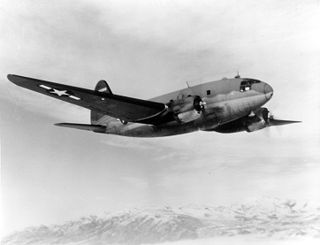
American Airlines Flight 383 was a nonstop flight from New York City to Cincinnati on November 8, 1965. The aircraft was a Boeing 727, with 57 passengers, and 5 crew on board. The aircraft crashed on final approach to the Cincinnati/Northern Kentucky International Airport located in Hebron, Kentucky, United States. Only three passengers and one flight attendant survived the accident.

Progress Multi Trade Air Flight 241 was a scheduled domestic passenger flight from Siem Reap to Sihanoukville, Cambodia. The flight was operated by regional airliner PMTair using an Antonov An-24. On 25 June 2007, the Antonov An-24, registered as XU-U4A, disappeared over the Cambodian jungle near Bokor Mountain in Kampot while on approach to Sihanoukville. A massive search and rescue operation ensued with thousands of soldiers and police scoured the area. The aircraft was found to have crashed in southwestern Cambodia, northeast of Dâmrei Mountains. All 22 people on board, most of whom were South Korean tourists, were killed. It remains as the second deadliest air disaster in Cambodian history.

On the evening of 30 November 1961, Ansett-ANA Flight 325, a service from Sydney to Canberra, Australia, operated by a Vickers Viscount 720, broke up in mid-air and crashed shortly after takeoff, when it encountered a severe thunderstorm. All 15 people on board were killed.

Continental Charters Flight 44-2, a domestic non scheduled passenger flight from Miami, Florida to Buffalo, New York, crashed on December 29, 1951 near Napoli, New York. The twin engine C-46 Commando, registration N3944C, crashed approximately 10:25 pm in adverse weather conditions. Of the four crew and 36 passengers on board, three crew members and 23 passengers perished. The flight crew's poor judgment in attempting a flight by visual reference during instrument weather conditions was the cause of the accident.

Bhoja Air Flight 213 was a domestic scheduled passenger flight operated by Pakistani private airline Bhoja Air from Karachi to Islamabad. On 20 April 2012, the Boeing 737-236A aircraft serving the route crashed in bad weather during the final approach killing all 121 passengers and 6 crew on board, it remains as the second deadliest air disaster in Pakistan.

Aeroflot Flight 1802 was a commercial flight from Vinnytsia to Moscow that crashed after the rudder deflected sharply and the propellers feathered on 15 May 1976. All 52 passengers and crew aboard the aircraft perished in the crash.

Aeroflot Flight 99 was a Tupolev Tu-124 operating a scheduled domestic passenger flight from Leningrad to Murmansk, both in the Soviet Union, which crashed while attempting to land on 11 November 1965. Of the 64 passengers and crew on board, 32 were killed in the accident, and many of the survivors sustained injuries.

On 5 August 1984, a Biman Bangladesh Airlines Fokker F27-600 crashed into a marsh near Zia International Airport in Dhaka, Bangladesh while landing in poor weather. The aircraft was performing a scheduled domestic passenger flight between Patenga Airport, Chittagong and Zia International Airport, Dhaka.

CAAC (中国民航), formerly the People's Aviation Company of China (中国人民航空公司), was the airline division of the Civil Aviation Administration of China and the monopoly civil airline in the People's Republic of China. It was founded on 17 July 1952, and merged into CAAC on 9 June 1953. In 1988, the monopoly was broken up and CAAC was split into six regional airlines, which later consolidated into China's Big Three airlines: Beijing-based Air China, Guangzhou-based China Southern Airlines, and Shanghai-based China Eastern Airlines.

Saratov Airlines Flight 703 was a domestic passenger flight from Moscow Domodedovo Airport to Orsk Airport in Russia. On 11 February 2018, the aircraft serving the flight, an Antonov An-148-100B, crashed shortly after take-off, killing all 71 people on board – 65 passengers and six crew members.

Iran Aseman Airlines Flight 3704 was a scheduled Iranian domestic passenger flight from Iranian capital Tehran Mehrabad International Airport to Yasuj in southwest Iran. On 18 February 2018, during its approach to Yasuj, the aircraft serving the flight, an ATR 72-212 operated by Iran Aseman Airlines, crashed into Mount Dena in the Zagros Mountains near Noqol village in Semirom county, Isfahan Province. All 66 people on board, including 60 passengers and 6 crew members, were killed.

Aeroméxico Connect Flight 2431 (SLI2431/5D2431) was a Mexican domestic scheduled passenger flight bound for Mexico City that crashed on takeoff from Durango International Airport on July 31, 2018. Shortly after becoming airborne, the plane encountered sudden wind shear caused by a microburst. The plane rapidly lost speed and altitude and impacted the runway, detaching the engines and skidding to a halt about 1,000 feet (300 m) beyond the runway. The plane caught fire and was destroyed. All 103 people on board survived, but 39 passengers and crew members were injured.

Petropavlovsk-Kamchatsky Air Flight 251 (PTK251) was a domestic Russian scheduled passenger flight from Petropavlovsk-Kamchatsky to Palana, both in Kamchatka Krai in the Russian Far East. On 6 July 2021, the Antonov An-26 serving the flight crashed on approach to Palana, killing all 28 passengers and crew on board.

The 1970 Batagay An-24 crash was an aviation accident that occurred on Wednesday, January 28, 1970, in the vicinity of Batagay involving an An-24B aircraft operated by Aeroflot, resulting in the death of 34 people.














